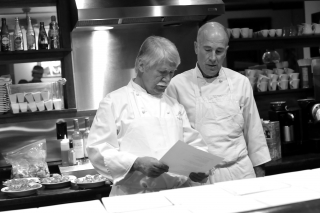
A Culinary Degree is Incomplete without Storytelling and Inquisitiveness
03 October 2022Creating something memorable and unique is born from the desire to ask why and stretch in new directions.
By Paul Sorgule, MS, AAC
Feedback & comments: This email address is being protected from spambots. You need JavaScript enabled to view it.
I have given considerable thought to the profile of the whole chef during my quest to discover the most impactful culinary curriculum. A whole chef is a creative person, a visionary, technically proficient, savvy as a businessperson, understands the human condition, and is organized to a fault. Thinking beyond the typical sequence of skill development seems important when considering the broader scope of chef-dom. This has allowed me to build a case for storytelling as an essential component of an impactful curriculum.
Educators understand the importance of the cooking process, the way things are done in the kitchen and the specific reasons why. The right and critical way to make a stock; correct dimensions for vegetable cuts; established proportions of celery, carrots and onion in a mirepoix; or the steps involved in braising a lamb shank. These steps are well-established and supported.
However, processes don’t inspire guests enough to patronize a restaurant. Processes without a compelling story are rather boring. The most effective chefs and the most intriguing restaurants are filled with compelling stories such as the chef’s background, the building’s history, the ingredient’s story, or the farmers, fish mongers, cattle ranchers, bakers, millers, winemakers, and brewers that help fill in the story’s blanks. These stories define the experience. So, this being the case – shouldn’t a chef’s education include a deeper understanding of storytelling and communicating what is behind the menu?
Chefs tell stories through the way a plate is designed and presented with a balance of colors and textures, symmetry, and shape; how the table is set to support the story (the type and design of plates, glassware, flatware, linen, and centerpiece); the ambience of the dining room; the music to complement the concept; the lighting; and even the menu’s layout. Everything in a well-executed restaurant builds into the story. What should an ideal culinary curriculum include if the story is to develop and the student is to build those storytelling skills?
Art appreciation
Impressionist, realist, surrealist, cubist, still life paintings, pastels, pointillism, and sculpture can all inspire a cook to think about how best to design a plate of food for the greatest eye appeal. The visual impact of the dining room and the tabletop can also benefit from an understanding of visual stimulation to the dining experience. Shouldn’t this be part of a young cook’s education?
Components of design
Guests’ experiences improve when the eating area is designed with a knowledge of color palettes and how the blending of shapes, shading, height, and definition of the plate’s point of origin is created. Also, guests can connect colors with feelings and their experiences can change based on lighting. These details separate a good restaurant from a great one. Shouldn’t this be part of a young cook’s education?
Music appreciation
Music has structure and foundations just like cooking, but it also opens the door to successful improvisation. Knowing how this takes place can set the stage for the desire to break out of the normal and work food and food presentation in unique ways. Also, knowing how music and the plate of food intertwine will help the chef compose a dining experience that connects all the human senses. Shouldn’t this be part of a young cook’s education?
Creative writing and storytelling
It was Richard Melman, the Chicago restaurateur and owner of Lettuce Entertainment Group, who built every new concept from an initial story with characters, environments, feelings and outcomes. A restaurant would come to life from this story. The story was known and embraced by every manager, chef and all employees so that it was felt by all who worked and dined in the operation. It was the story that structured the experience – everything had its place in the story. Learning to translate a student’s thoughts and stories into writing should be essential. Appreciation for writing structure will come with practice but being able to express what a student feels or knows on paper is a major step in the right direction. Shouldn’t this be part of a young cook’s education?
History
And of course, to best represent the food that graces a plate, chefs must understand, and as much as possible, the connection between history and culture. What was the story of the people who cooked and composed flavors of this cooking style? A world history class touching on components of ethnicity and cultural differences are as important to a dish as the right amount of salt. Shouldn’t this be part of a young cook’s education?
Maybe not at the certificate or associate degree level, but certainly for those programs offering baccalaureate degrees – these components would be crucial for deeper learning and understanding. These components help to develop inquisitiveness – the desire to ask why to stretch in new directions, creating something memorable and unique. A cook and chef who embraces inquisitive thought are always ones to watch.
Food for thought.
PLAN BETTER – TRAIN HARDER
Paul Sorgule, MS, AAC, president of Harvest America Ventures, a mobile restaurant incubator based in Saranac Lake, N.Y., is the former vice president of New England Culinary Institute and a former dean at Paul Smith’s College. Contact him at This email address is being protected from spambots. You need JavaScript enabled to view it..
